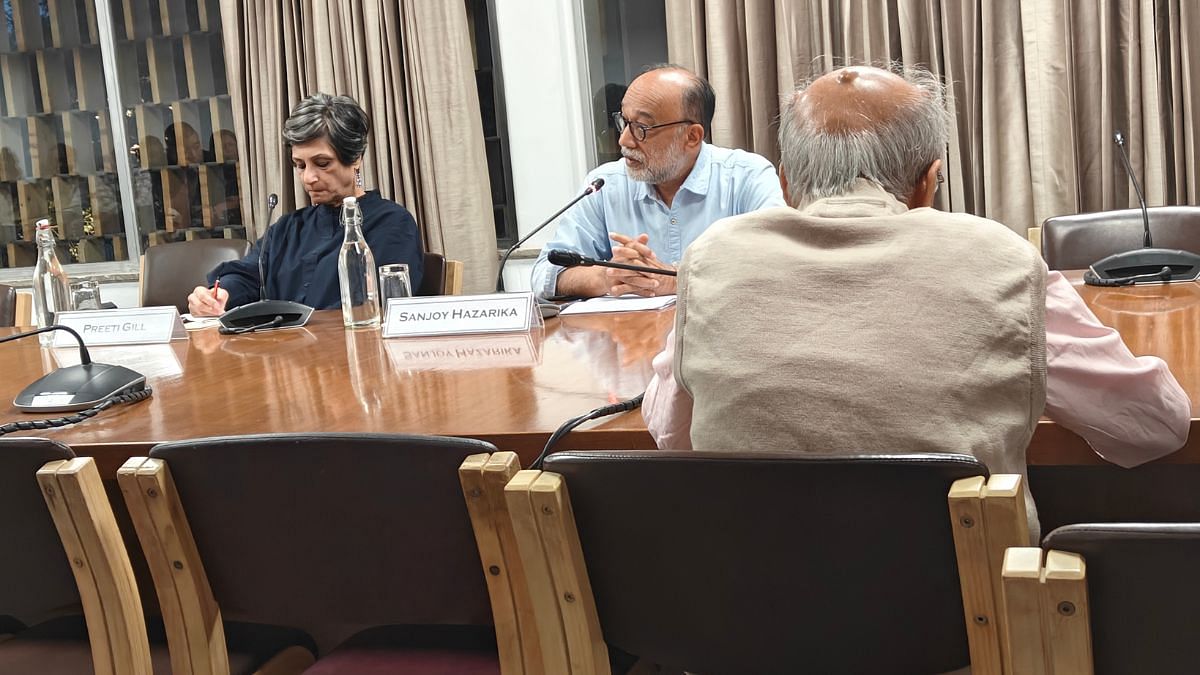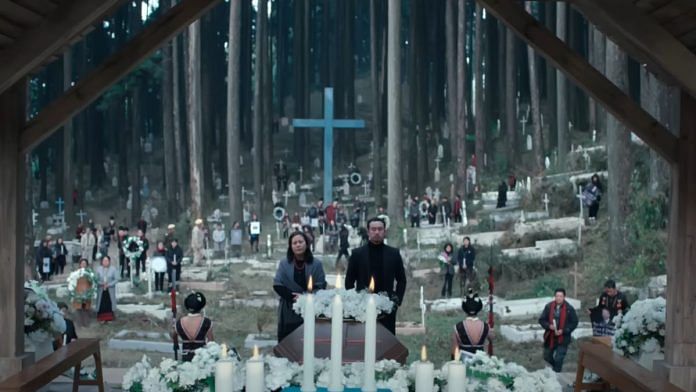New Delhi: To understand Nagaland, the second season of the Amazon Prime series Paatal Lok is a good starting point.
“What made a difference was that the producer [Sudip Sharma] has lived in Assam and travelled extensively in the region, and is sensitive to local residents here,” said Sanjoy Hazarika, founder of the Centre for North East Studies and Policy Research in New Delhi.
Hazarika was delivering a talk titled ‘A Place Called Home: Identity and Belonging’ at the India International Centre earlier this month.
It was part of IIC’s new series, ‘A Fabric of Narratives: The Many Facets of North East India’, which focuses on different aspects of the region, from cuisine to culture.
During his hour-long lecture, Hazarika covered 80 years of the Northeast—history, government policies to politics—with a focus on Assam, Nagaland and Mizoram.
But it’s only in recent years that the region and its history began seeping into mainstream popular culture.
Books like The Collector’s Wife by Mitra Phukan may be fiction, but they document the region’s struggle through personal lived experiences, explained Hazarika while recommending works set in the rapidly changing Northeast of the 1990s and 2000s.
The Collector’s Wife, for instance, looks at the troubled years of insurgency in Assam. Murder mysteries by Ankush Saikia capture Shillong’s gritty times and tough streets, and Temsola Ao’s These Hills Called Home is a collection of stories revolving around Naga identity.

New Northeast life
Insurgency was once a determining factor in the socio-political and cultural landscape of the Northeast. Things only started to change over the last few decades, due to the push for peace by the central and state governments.
The National Socialist Council of Nagaland – Isak-Muivah (NSCN-IM), also known as the Isak-Muivah faction, signed the Framework Agreement with the Government of India in August 2015. Subsequently, it also signed the Agreed Position with the working committee of the Naga National Political Groups (NNPGs) in November 2017. This started the discussions on what the peace process would look like in Nagaland.
The Armed Forces (Special Powers) Act, 1958 (AFSPA) has also been removed from parts of the region, including parts of Nagaland, where it was first introduced. “This confidence is reflected in the celebration of the Hornbill Festival, resulting in tens of thousands of footfalls from across India and abroad. New cafes and startups, music gigs, sports events are also popping up all the time,” said Hazarika.
Kohima has emerged as one of the cities with massive infrastructure changes.
“Kohima, like Shillong and other state capitals, is transitioning from a town to a city with traffic jams, malls, and stores. There is concretisation, with new buildings made of glass and mortar, tearing down old wooden structures. The profile of the rural landscape are changing and so are the people living there,” Hazarika added.
There is also a focus on establishing new industries in the region. There are investments from some of the biggest names in India’s economy, including the Tata Electronics chip plant in Silchar, which will be the next big shift in the insider-outsider debate for the region. But the concern for many is if this development will come at the cost of disruption of ‘traditional’ lives.
“The bridge that remains to be completed is not just with bricks, mortar, steel, and iron but with words and music, and above all, goodwill and shared lives,” said Hazarika.
In what felt like a condensed history lesson of the region, Hazarika spoke about the movements of self-determination and identity politics of Nagaland, Mizoram, and Assam, and how they informed each other.
“All these stories [novels] that have emerged over 20-25 years capture the essence of what many people in the region went through in the 1990s and 2000s,” said Hazarika.
Also read: Justice Indira Banerjee wants no fanfare when a woman becomes a judge. ‘It should be normal’
World Wars & the Naga identity
World War I played an important role in shaping the political identity of the Northeast. At the time, thousands of Nagas were drafted into the British Army’s Labour Corps. Their experiences helped shape their political awareness.
Neither the British nor the subsequent political regime in India inspired confidence among Naga leaders. The arrival of the Japanese during World War II and the Battle of Kohima in 1944 cemented the belief that Nagaland should have separate rule. Formed in 1946 and headed by Zapu Phizo, the Naga National Council began pushing for sovereignty, a demand that got stronger after Independence.
“Nehru’s own position was that the Naga territory was much too small to stand by itself politically and economically, and it must form a part of India,” said Hazarika.
The Naga movement for self-determination eventually became a starting point for the Mizo people to resist the Assam government’s callousness during the 1959 famine. Laldenga, the head of Mizo National Front (MNF)—who later became the chief minister of the new state of Mizoram—also pushed for a separate nation for the Mizos.
Hazarika discussed the separatist movements to show how histories of the communities and states in the Northeast are linked together intrinsically, and sometimes, have impacted each other like a domino effect.
An interesting anecdote shared by Hazarika was the role of National Security Advisor Ajit Doval in dealing with an insurgent group. Doval then headed the Mizoram unit of Intelligence Bureau (IB), called Subsidiary Intelligence Bureau in 1972.
By the time he arrived in the region, the violence had waned and the tide was turning against the MNF.
When IB organised an emergency convention of the MNF in Calcutta (Kolkata) in March 1976, it was said that Doval had paved the way for the hostile leaders to attend. Doval even invited MNF leaders for lunch at his home in Mizoram, where his wife prepared the meal. These efforts became the foundation for the Mizo Peace Accord, signed a decade later under Rajiv Gandhi’s leadership, after which full statehood was granted to Mizoram.
Also read: British-era tanks & jumbled pipelines—this heritage walk explores Mumbai’s ties to water
Fall of insurgency
The decline of insurgency in the Northeast wasn’t a linear process. The imposition of AFSPA in 1958 resulted in an even stronger response by insurgent groups across the states, resulting in demands for protection money from residents to keep these outfits running.
“Public fatigue set in when people started resisting against extortion, rebels, and killings,” said Hazarika. He added that this fatigue eventually became the reason insurgent groups started falling apart.
But it was not just the Indian Army’s actions that helped quell the growing power of the United Liberation Front of Assam (ULFA), an armed separatist organisation. Bangladesh, Bhutan, and Myanmar had a big role to play.
Under the leadership of then-Bangladesh Prime Minister Sheikh Hasina, ULFA members were detained and handed over to Indian authorities at the Meghalaya border. ULFA leader Arabinda Rajkhowa was among those arrested in Bangladesh.
Bhutan’s army also routed rebels, driving them across the border so the Indian Army could apprehend them. The decline of insurgency and the introduction of new policies and peace accords ushered in a new era. The region soon moved from guns and violence to industries, tourism, and music festivals.
“These changes are not just celebrations of our words, but they are a celebration of our times so that we can write freely about the issues that matter, and speak of them,” said Hazarika.
However, an audience question showed that outsiders’ perception of the Northeast is yet to change: “You have spoken of so much violence. Can you tell me a place in the Northeast which is safe for travelling?”
Hazarika smiled wryly before responding.
“I was talking about the violence of the past. There are hundreds of flights to the region. You can go anywhere. Probably do not visit Manipur right now, since it is tense. But other places have great weather, and you can visit them.”
(Edited by Prasanna Bachchhav)







Paatal lok is on Amazon prime , it’s not netflix